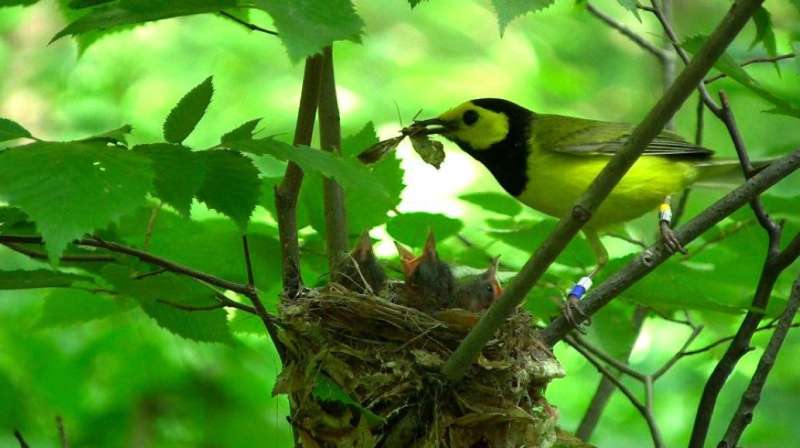Feather replacement or parental care? Migratory birds desert their offspring to molt

A new study shows that when feather replacement and parental care overlap in time, migratory songbirds make a striking trade-off; they desert their offspring, leaving their mates to provide all remaining parental care.
This radical solution to conflict between parental care and the annual molt provides "a nice illustration of the complex lives that migratory songbirds lead," says Ron Mumme, the study's author and Professor of Biology at Allegheny College in northwestern Pennsylvania. "They have to negotiate conflicting demands and make difficult trade-offs and compromises, just like we do."
Migratory songbirds that breed in North America confront serious issues with time management. After spending a relatively leisurely winter and early spring luxuriating in warm tropical climates, they migrate north for a brief but highly eventful summer in North America, during which they must complete three energetically demanding and time-consuming tasks: (1) they must build nests, lay eggs, and provide for their offspring until the young reach independence, (2) they must completely replace all the feathers in their plumage as part of the annual molt, and (3) they must prepare for the fall southward migration by eating prodigiously and storing the body fat that will fuel their long-distance flights.
Completing all three tasks during a short summer is challenging; when the tasks overlap in time, migratory songbirds may be forced to make compromises and trade-offs.
The new study, published in The Auk: Ornithological Advances, a journal of the American Ornithological Society, examines the trade-offs that birds make when parental care overlaps with the annual molt. It focuses on the Hooded Warbler, a songbird that spends a brief summer nesting in the forests of eastern North America before migrating south to winter along the Caribbean coast from southern Mexico to Panama.
Hooded Warblers have an unusual combination of traits that makes conflicts between parental care and molt likely. First, their prolonged nesting season extends into August, a time typically reserved for feather replacement. Second, their diet consists largely of flying insects that are captured in an unusual way; they use their white tail spots and tail-flicking behavior to flush prey hidden in vegetation. Third, the birds employ the odd strategy of molting and replacing all their tail feathers simultaneously at a time when they are also replacing the primary flight feathers on each wing.
Hooded Warblers simultaneously engaged in both parental care and tail molt therefore find themselves in a difficult position; they have to find enough food to feed themselves and their offspring at a time when their own nutritional requirements are high and their ability to fly and forage is significantly compromised.
So what happens when a molting Hooded Warbler loses all its tail feathers while it is still feeding nestlings or fledglings? About 70% of the time it deserts, leaving its mate responsible for all remaining parental care.
"For that one week when they are without a tail, Hooded Warblers are the goofiest looking birds you can imagine," says Mumme. "But the big problem is flying and foraging are just not easy during that time. Molting birds typically hunker down in thickets and keep a low profile, and that usually isn't compatible with parental care."
Males arrive on the breeding grounds earlier than females and nearly always begin molt earlier than their mates. As a result, most cases of desertion involve molting males deserting nestlings and recently fledged juveniles, but rare cases of single-parent desertion by molting females also occur.
One intriguing aspect of the study is that it identifies two factors that explain why some molting parents do not desert; age of the dependent offspring, and age of the parent. If the offspring are older and close to the age of independence, which occurs about 35 days after hatching, a tailless molting parent may continue providing care. If the offspring are younger and more demanding, however, a molting parent nearly always deserts. Similarly, old veteran males are less likely to desert than are younger males with fewer years of previous breeding experience. These observations indicate that Hooded Warblers are acutely sensitive to the costs of providing parental care during molt. "If the costs of continuing care are relatively modest—for example, if it's an experienced male with offspring close to independence," says Mumme, "a molting parent may elect not to desert."
A second intriguing finding is that females deserted by males and forced to provide all remaining parental themselves appear to have about the same chance of surviving to the following year as non-deserted females. In fact, in cases where both a deserting male and his mate return the following year, the female will more likely than not re-mate with the same male that ditched her the previous year. "Male desertion doesn't seem to be a big problem for females," says Mumme. "It may just be an unavoidable consequence of the prolonged nesting season and early male molt, and females are able to deal with it just fine."
Mumme's research on molt and desertion is continuing. He is currently investigating the effects of single-parent desertion on growth and survival of offspring, and how females adjust their molt and migration schedules to deal with male desertion.
More information: Ronald L. Mumme, The trade-off between molt and parental care in Hooded Warblers: Simultaneous rectrix molt and uniparental desertion of late-season young, The Auk (2018). DOI: 10.1642/AUK-17-240.1
Provided by American Ornithological Society

















